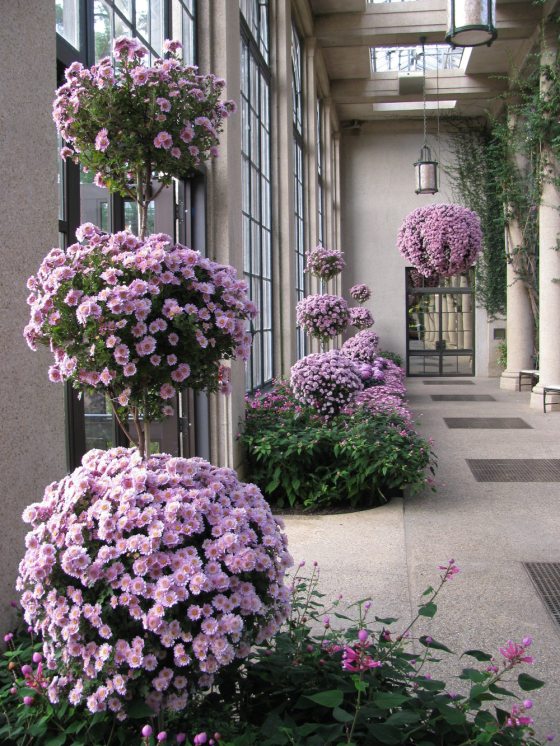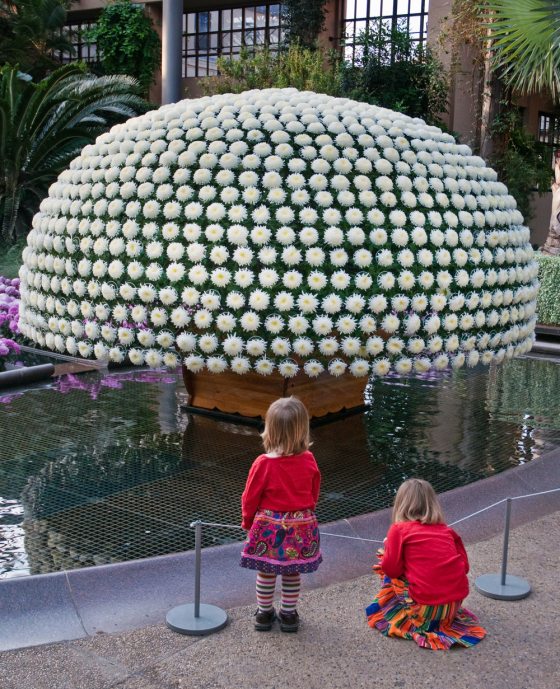When our designers plan our displays, they think about (among many other things) form, color, and dimension—not just two-dimensional, uniform beds of flowers, but how to create height and interest. Luckily for our designers, our horticulturists and growers are constantly working to "raise the standard" by training an ever-increasing list of plants into the "standard" form.

Crape-myrtle standards in Exhibition Hall. Photo by Larry Albee.
“Standard” is the name we give to plants trained into the form of a tree with a single main trunk. The lower part is exposed with no branches; the upper heavily branched crown, known as the “head,” is usually pruned into a rounded form.
Here at Longwood we currently use this training method on about 30 different kinds of plants, and we’re continually evaluating the suitability of new plants for this technique. The plants range from fairly well known varieties, such as poinsettias and crape-myrtles, to ones that are quite unusual, such as Senna, Westringia, and Clerodendrum.

Senna standard in Orangery.
The time it takes to produce a standard varies, depending on the species and the size desired for the finished product. For example, a myrtle (Myrtus communis) standard takes five years to grow to an eight-foot height with a four-foot diameter head. But it takes just two years to grow a poinsettia standard to the same size, and only six to seven months to grow one 3½ feet tall with a two-foot diameter crown.

Clerodendrum standards. Photo by Hank Davis.
The process can be divided into two main phases. The goal of the first phase is to take a newly propagated plant and train it as a single upright stem, which would yield the final trunk of the standard. This means that all side branches are pruned or “pinched” (between thumb and finger) when they are very small. Only the shoot tip at the apex of the main stem is allowed to continue growing.

Westringia standards.
This is fairly easy with plants that tend to grow quickly. However, with plants that grow more slowly, this phase can be shortened by choosing a vigorous variety for the trunk, then grafting on the slower growing variety for the head. Another problem with slow growers is that they tend to form crooked trunks. This can be resolved by growing the plant for a long enough period of time to build a large root system, then cutting the plant back near the soil surface. The plant often responds by producing vigorous shoots—selecting one and removing the rest will further increase the vigor of the remaining shoot, which will usually grow rapidly and with a straight trunk, thus achieving the desired quality.

Chrysanthemum spirals. Photo by Larry Albee.
Phase two begins once the plant reaches a height slightly taller than where the bottom of the finished head will be. The goal of this second phase is to encourage as much branching as possible, in order to create a dense head. Not only does this achieve the desired aesthetic form, but it also generates as many flowers as possible in plants being grown for floral display. Branching is encouraged by repeatedly pruning or pinching the tips of the side branches. As the form of the head develops, the branches are pinched at appropriate lengths to result in a rounded form. The natural tendency of the plant will also impact the shape of the head: i.e., plants that tend to grow slowly and branch profusely will have a tighter, more rounded head like the Senna; plants that are more vigorous and less inclined to branch will have a more open, elongated head like the Westringia.

Chrysanthemum three-ball standards. Photo by Karl Gercens.
Some modifications of the natural standards grown here at Longwood are spirals and cloud forms, done primarily with Chrysanthemum plants; and two-ball or three-ball standards, typically done with Chrysanthemum or coleus.
Another derivative of the standard is the topiary standard. In this case the goal is to produce the overall shape of a small tree. However, the lower portion is usually contrived using wood or metal and decorated in a way to make it look like a trunk. The head is created by attaching a spherical grilled framework to the top of the pseudo-trunk and placing many individual plants into the framework sphere, as we do when assembling hanging baskets. Many kinds of plants can be used to create a topiary standard. Here at Longwood we use Begonia, Phalaenopsis orchids, and Fuchsia, among others.

Begonia topiary standards. Photo by Larry Albee.

Phalaenopsis topiary standards in the Orangery.
In Japan, the art form of the standard has been taken to the extreme to create what is known as the Thousand Bloom Mum. In this case the final form will have anywhere from 500 to over 2,000 perfectly spaced flowers, producing a head that can be over twelve feet in diameter. Longwood growers have learned this technique from Japanese experts, and the result can be seen in the picture below.

Thousand Bloom Mum. Photo by Larry Albee.
If you, too, are fascinated by this technique, choose a plant that you like and start pinching, pruning, and training. Then let us know how it turns out. Perhaps you can teach us how to grow something unique, and set new "standards" for our displays!
The following list includes plants currently grown as standards at Longwood Gardens.
Plant Name (Common Name)
- Abutilon (Flowering Maple)
- Acalypha hispida (Chenille Plant)
- Allamanda cathartica 'Hendersonii' (Allamanda)
- Anisodontea x hypomandarum (African Mallow)
- Argyranthemum 'Vera' (Argyranthemum)
- Buddleja 'Winter Waterfall' (Butterfly bush)
- Buddleja asiatica (Butterfly bush)
- Cestrum (Willow-leaved Cestrum)
- Chrysanthemum x morifolium 'Gum Drop' (Chrysanthemum)
- Chrysanthemum x morifolium 'Heyward Horry' (Chrysanthemum)
- Clerodendrum quadriloculare (Bronze-leaved Glorybower)
- Duranta erecta 'Geisha Girl' (Skyflower)
- Eucalyptus gunnii (Cider Gum)
- Euphorbia cotinifolia (Caribbean Copper-plant)
- Euphorbia pulcherrima 'Annette Hegg Brilliant Diamond' (Poinsettia)
- Euphorbia pulcherrima 'Beckmanns Altrosa' Maren (Poinsettia)
- Euphorbia pulcherrima 'KLEW01010' Santa Claus White (Poinsettia)
- Euphorbia pulcherrima 'PER1072' Winter Rose Early Red (Poinsettia)
- Euphorbia pulcherrima Santa Claus Red (Poinsettia)
- Fuchsia x hybrida 'Gartenmeister Bonstedt' (Fuchsia)
- Fuchsia x hybrida 'Lord Beaconsfield' (Fuchsia)
- Hamelia patens (Firebush)
- Lantana camara 'Radiation' (Lantana)
- Murraya paniculata (Orange-jessamine)
- Myrtus communis (Myrtle)
- Plumbago auriculata 'Monott' (Cape Leadwort)
- Rhaphiolepis 'Pink Lady' (Indian Hawthorn)
- Senna bicapsularis 'Butter Crème' (Senna)
- Solenostemon scutellarioides 'Pineapple Beauty' (Coleus)


